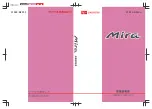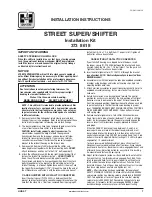
SERVICING AND MAINTENANCE
87
Coolant Level
The coolant bottle provides a quick visual method for
determining that the coolant level is adequate. With the
engine off and cold, the level of the engine coolant
(antifreeze) in the bottle should be between the ranges
indicated on the bottle.
The radiator normally remains completely full, so there is no
need to remove the radiator/coolant pressure cap unless
checking for engine coolant freeze point or replacing coolant.
Advise your service attendant of this. As long as the engine
operating temperature is satisfactory, the coolant bottle need
only be checked once a month.
When additional engine coolant is needed to maintain the
proper level, only OAT coolant that meets the requirements of
the manufacturer Material Standard MS.90032 should be
added to the coolant bottle. Do not overfill.
Cooling System Notes
NOTE:
When the vehicle is stopped after a few miles/kilometers
of operation, you may observe vapor coming from the front
of the engine compartment. This is normally a result of
moisture from rain, snow, or high humidity accumulating
on the radiator and being vaporized when the thermostat
opens, allowing hot engine coolant (antifreeze) to enter
the radiator.
If an examination of your engine compartment shows no
evidence of radiator or hose leaks, the vehicle may be
safely driven. The vapor will soon dissipate.
Do not overfill the coolant expansion bottle.
Before the onset of freezing weather (where appli
-
cable) check the condition of coolant in radiator and
coolant expansion bottle. If the coolant needs to be
added, the contents of the coolant expansion bottle
must also be protected against freezing. Refer to
“Adding Coolant” in this section for further information.
Check the coolant freeze point in the radiator and in
the coolant expansion bottle. If engine coolant needs
to be added, the contents of the coolant expansion
bottle must also be protected against freezing.
If frequent engine coolant additions are required, the
cooling system should be pressure tested for leaks.
Maintain engine coolant concentration at a minimum
of 50% OAT coolant (conforming to MS.90032) and
distilled water for proper corrosion protection of your
engine which contains aluminum components.
Make sure that the coolant expansion bottle overflow
hoses are not kinked or obstructed.
Keep the front of the radiator clean. If your vehicle is
equipped with air conditioning, keep the front of the
condenser clean.
Do not change the thermostat for Summer or Winter
operation. If replacement is ever necessary, install
ONLY the correct type thermostat. Other designs may
result in unsatisfactory engine cooling performance,
poor gas mileage, and increased emissions.
B
RAKE
S
YSTEM
In order to ensure brake system performance, all brake
system components should be inspected periodically.
Refer to the “Service and Warranty Handbook” for the
proper maintenance intervals.
WARNING!
Riding the brakes can lead to brake failure and possibly
a collision. Driving with your foot resting or riding on
the brake pedal can result in abnormally high brake
temperatures, excessive lining wear, and possible brake
damage. You would not have your full braking capacity
in an emergency.
23_W7_EIG_EN_IN_t.book Page 87
















































